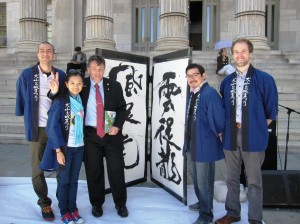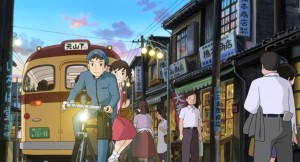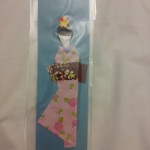WIT Life #234: Tokyo Rose
WIT Life is a periodic series written by professional Writer/Interpreter/Translator Stacy Smith (Kumamoto-ken CIR, 2000-03). She starts her day by watching Fujisankei’s newscast in Japanese, and here she shares some of the interesting tidbits and trends together with her own observations.

Last night I had the chance to see the play Iva: The Myth of Tokyo Rose at Asia Society. Prior to seeing the performance I had heard of Tokyo Rose, but was not aware of what the story behind this name was. It was actually created by Allied forces in the South Pacific during WWII to describe English speaking female broadcasters of Japanese propaganda, which was intended to disrupt the morale of the Allied force listeners.
The play’s protagonist is Iva Toguri D’Aquino, a Japanese-American who later married a Filipino. She had the misfortune of going to Japan to take care of a sick relative in 1941, and being stuck there once war broke out. When the Japanese government asked her to renounce her American citizenship and she refused, she was forced to work at Radio Tokyo as an announcer. The program was The Zero Hour, which consisted of propaganda-tinged Read More
Let’s Walking
Posted by Benjamin Martin, a 5th year JET on Kume Island in Okinawa, publisher of the blog MoreThingsJapanese.com and author of the award-winning YA fantasy series Samurai Awakening (Tuttle).
 Sanpo is Japanese for a ‘walk,’ and it’s a popular pastime here. From the bureaucratic samurai of the Tokugawa period who would wander among the cherry trees and write poetry, to modern office workers trying to keep fit, walking is still a much appreciated activity in Japan.
Sanpo is Japanese for a ‘walk,’ and it’s a popular pastime here. From the bureaucratic samurai of the Tokugawa period who would wander among the cherry trees and write poetry, to modern office workers trying to keep fit, walking is still a much appreciated activity in Japan.
Japan is also a land with a rising elderly population. It has one of the longest life expectancies in the world. As communities and towns have ever older populations it is also becoming ever more important to promote fitness in populations that will strain public health services ever more if not kept healthy. One way municipalities can do this is by hosting events such at the one Kumejima Town hosts every January.
The 久米島のんびりウオーク or Kumejima’s Leisure Walk is a two-day yearly event, part of the larger Okinawa Marching league. Participants come from all over Japan. As a resident of Kume Island I attended this event first in 2011.
The first day offered 32km, 16km, and 5km courses and the second day offered 20km, 10km, and 5km courses. One participant was a 86-year-old who planned on completing the full 32km course!
Both days featured different courses through the island. Participants entered with a nominal fee, and were provided maps and completion certificates. Along the way stickers were awarded at checkpoints, and food stations were set up where walkers could rest and eat.
I did the 16km walk on the first day of the event. Walkers stretched together and announcements were made. As with many events there was an MC tapped for the event who extolled everyone to do a good job. The 32km group did the same about half an hour before, so everyone in the 16km group set off together.
 Each group set off to the sound of a taiko drum performance. All along the way were supportive Japanese Flags with messages urging the participants on. These helped guide the walkers through the more remote areas. There were also tea and water stations along the way, with great views and interesting conversations.
Each group set off to the sound of a taiko drum performance. All along the way were supportive Japanese Flags with messages urging the participants on. These helped guide the walkers through the more remote areas. There were also tea and water stations along the way, with great views and interesting conversations.
 One lady I talked to came all the way from Yokohama to participate. She said it was a great way to see more of Japan, while keeping in shape. She talked to me because her children live in the states and wanted to know why I was there. ^_^ All in all, it was a great morning/afternoon spent among Kumejima’s beautiful walkways. Do you want to visit new places and keep in shape? Let’s Walking!
One lady I talked to came all the way from Yokohama to participate. She said it was a great way to see more of Japan, while keeping in shape. She talked to me because her children live in the states and wanted to know why I was there. ^_^ All in all, it was a great morning/afternoon spent among Kumejima’s beautiful walkways. Do you want to visit new places and keep in shape? Let’s Walking!
This post originally appeared on MoreThingsJapanese.com. To learn more about Kumejima visit KumeGuide.com.
WIT Life #233: Live Your Dream
WIT Life is a periodic series written by professional Writer/Interpreter/Translator Stacy Smith (Kumamoto-ken CIR, 2000-03). She starts her day by watching Fujisankei’s newscast in Japanese, and here she shares some of the interesting tidbits and trends together with her own observations.
Last month I had the opportunity to interpret for Mr. Hakubun Shimomura, the current Minister of Education, Culture, Sports, Science and Technology (MEXT or 文部科学省) during his time in Washington, DC. His schedule included a variety of official visits and meetings, including to a charter school and with various U.S. government agencies, but to me the most personally significant part of working with him was when he addressed the local JETAA chapter (In addition to MEXT, JET is carried out by the Ministry of Internal Affairs and Communications (MIC or 総務省), the Ministry of Foreign Affairs (MOFA or 外務省) and the Council of Local Authorities for International Relations (CLAIR or 自治体国際化協会).
Minister Shimomura provided opening remarks at a reception before the screening of a documentary called Live Your Dream, which tells the story of JET Taylor Anderson who lost her life in the tsunami two years ago. Also featured in this film is the other JET who passed away during this natural disaster, Montgomery (Monty) Dickson. Family members of both Read More
JQ Magazine: JETAA New York Greets Distinguished Guests

Inuyama City Council Member Anthony Bianchi, center, poses with fellow JET alums at the Japan Friendship Festival, Brooklyn Borough Hall Plaza, May 2013. (Photo courtesy of Ann Chow)
By Ann Chow (Hyogo-ken, 2007-09) for JQ magazine. Ann is a native New Yorker and serves as the Membership Development Chair for the JET Alumni Association of New York.
On April 17, members of the JET Alumni Association of New York (JETAANY) were invited to attend a reception at the Nippon Club for the Governor of Tokyo, Naoki Inose, who was in New York to drum up support for his city’s bid for the 2020 Summer Olympics and Paralympics. Among the guests at the reception included Willie Banks, the three-time track and field Olympian, and world record holder from 1985-95 in Men’s Triple Jump. (Cool trivia: Banks speaks fluent Japanese.)
And on May 3, several JETAANY members, along with employees of CLAIR and the Japanese consulate, were on site to help Inuyama City Council Member Anthony Bianchi (Aichi-ken, 1987-91) and B. Bridges participants at the Japan Friendship Festival at Brooklyn Borough Hall Plaza. The B. Bridges program (short for “Brooklyn Bridge” as well as “Building Bridges” and “Be Bridges”) was created as a cultural exchange program by Bianchi and the administration of Xaverian High School, of which Bianchi is an alumnus.
“The idea for the B. Bridges exchange program was born 10 years ago at an event the Brooklyn Borough President, Marty Markowitz, held for me at Borough Hall after my first election, so it was great to be able to hold this, our Japan Friendship Festival: Inuyama Day at Borough Hall,” Bianchi said.
The program has sent close to 500 people from Brooklyn to Inuyama City and vice versa. This year, 40 participants came from Inuyama City to stay with families of students attending the school. On a beautiful sunny day, JETAANY members were able to help the group out at various booths which showcased tea ceremony, Japanese calligraphy, and traditional Japanese toys and wares.
“The cooperation of the Brooklyn Borough President’s Office, the Japanese Consulate of New York, the Japan Local Government Center, and the JET Alumni Association of New York were crucial to making this event successful,” explained Bianchi.
He added: “I was also proud of our B. Bridges members, as well as our exchange partners at Xaverian High School, who made great use of the opportunity. This, I believe, made the event a great experience for all those in attendance.”
For additional photos from the events, click here and here.
Justin’s Japan: Nippon in New York — Japan Day @ Central Park and a ‘Deadly She-Wolf’

CNN national correspondent Sandra Endo hosts Japan Day @ Central Park May 12. (Courtesy of @sandraendotv)
By JQ magazine editor Justin Tedaldi (CIR Kobe-shi, 2001-02) for Examiner.com. Visit his Japanese culture page here for related stories.
This month’s highlights include:
Sunday, May 12, 10:30 a.m.
Free
Now in its seventh year, Japan Day has won acclaim from New Yorkers from every walk of life, with Mayor Michael Bloomberg calling it an eagerly anticipated cultural event on the city’s calendar. For this year’s event, organizers are planning once again to have both the Japan Run (beginning at 8:00 a.m.) and the Japan Day Festival, emphasizing enjoyable activities for all ages that will deepen participants’ understanding and appreciation of Japanese culture—not to mention the food, drinks and snacks! Hosted by CNN national correspondent Sandra Endo, this year’s guest performers include Taiko Masala, Kylee, Yosakoi Dance Project 10tecomai, Chris Hart, and the Glory Gospel Singers.
May 16-June 2
Deadly She-Wolf Assassin at Armageddon!
La MaMa Experimental Theatre, 74 East 4th Street
$30 adults, $25 students/seniors
Deadly She-Wolf Assassin at Armageddon! is the latest music/theater and martial arts tour de force from collaborators Fred Ho and Ruth Margraff. A daring and imaginative homage to the 1970s Japanese raging cult manga and theatrical hit Lone Wolf and Cub (Kozure Ookami)—which has inspired many other adaptations and works in comic books and film over the past decades—Deadly She-Wolf explodes with a ferocious stylistic mix of Japanese Noh theater and modern-day anime and manga influences with unique multi-martial arts and sword fighting choreography and a glorious score fusing traditional Japanese music and soul-jazz. Raised as a weapon by a brutal conspirator, a young female assassin discovers that her target has spun the empire of Japan into crisis and ruin–and–is none other than her father. Torn between loyalty to her mission, her nation and her soul, she must face the unimaginable at the twilight of an imperial epoch.
For the complete story, click here.
JQ Magazine: Cultural Heritage Soars in San Francisco’s Japantown

Under the Peace Pagoda at the Northern California Cherry Blossom Festival, San Francisco, April 2013. (Preston Hatfield)
By Preston Hatfield (Yamanashi-ken, 2009-10) for JQ magazine. Preston received a B.A. in English literature with an emphasis in creative writing and a minor in Japanese at the University of California, Davis. After spending an amazing year on JET in Yamanashi, he spent a year writing and interning with book publishing companies in New York. He currently lives in Marin County, where he continues to cover local Japan-related stories for JQ, and teaches English as a second language at an international school in San Francisco.
This April marks the forty-sixth time that San Francisco has hosted the Northern California Cherry Blossom Festival. As one of the world’s top annual festivals of its kind and one of the largest Japanese American events in the country, the festival has made quite a reputation for itself, and each year it’s bigger and better. Whether you’ve been to Japan before and need a fix of your favorite street food, or you’re a newbie interested in exploring the culture, the NCCBF offers a comprehensive and top-notch Japan experience that includes traditional and modern elements.
If you’ve been to other festivals, you already know to expect tea ceremony demonstrations, doll exhibits, taiko performances, and cosplay competitions, but pay attention and you’ll also notice a powerful sense of community in every act and exhibit. Excepting a handful of wonderful guests from Japan (including this year’s Grand Marshal, renowned singer and actor Teruhiko Saigo), the NCCBF is put on wholly by the Bay Area’s Japanese American community, including some 300 volunteers, 50 organizations, schools, and groups, and is sponsored by a number of local businesses. In some respects, it’s their way of making a statement, as Allen Okamoto, co-chairman of the NCCBF, explains:
“One of the reasons I continue to volunteer with the festival is that Japantown is rapidly changing. The demographics of the community are changing with the intermarriage and lack of migration from Japan. I consider the festival as an institution the same as the Japanese language schools, the churches and other community organizations like the Japanese Community Youth Council, Kimochi, Inc. and the Japanese Cultural & Community Center. We are all continuing the culture and heritage of things Japanese.”
The festival has become something of a culture treasure here, and it’s no wonder. San Francisco, with a formidable but recently declining Japanese American population, is home to one of the last “true” Japantowns in the U.S., but some locals think that’s debatable. “I saw [at the festival] a hardworking community [bringing] culture and fun to Japantown, which for the rest of the year is slowly being eaten by non-Japanese businesses. Koreatown sometimes feels more appropriate,” said Bay Area resident and JET alum Mikeal Gibson.
Event: Tomodachi-Mitsui & Co. Leadership Program – Friday May 10th deadline
Thanks to JETAA NC’s Mark Frey for sharing this posting. Posted by Kay Monroe (Miyazaki-shi, 1995 -97). Click here to join the JETwit Jobs Google Group and receive job listings even sooner by email.
———————————————————————————————————
The TOMODACHI Initiative is now accepting applications for the 2013 TOMODACHI-Mitsui & Co. Leadership Program!
TOMODACHI is seeking twenty outstanding young American and Japanese professionals from the business and government sectors to participate in the TOMODACHI-Mitsui & Co. Leadership Program. This program is designed to inspire and motivate the next generation of young American and Japanese leaders to be active in U.S.-Japan relations.
– This program is NOT open to students.
– This program is for people already in the workforce under age 35.
– DEADLINE TO APPLY IS FRIDAY, MAY 10, 2013. Interested applicants should apply immediately.
– Applicants do not necessarily need experience living in Japan or speaking Japanese.
– People who work in tourism, government, education, high-tech –basically any industry field is open – are encouraged to apply.
Generously funded by Mitsui & Co., Ltd., participants will represent broad geographic diversity through different target cities each year with a target age range of 35 and younger. Delegates will be leaders, active in their respective fields, and committed to addressing local, regional, or global community concerns.
The U.S. delegation will travel to Japan July 26-August 3 and the Japan delegation to the United States September 8-16. This bicultural experience provides outstanding young leaders with unique access to leaders in the U.S.-Japan arena and an opportunity to broaden their perspectives to enhance the work or initiatives in their professional fields.
To apply, go to http://usjapantomodachi.org/2013/04/5887/
Also, questions about the program should be addressed to Noriko Litwin (nlitwin@onemanagementgroup.com ) or Wesley Stockstill (wesley@onemanagementgroup.com ).
Career: DISCO Sydney Career Forum for bilingual jobs in Asia – May 11, 12
Via JETAA New South Wales. Posted by Kay Monroe (Miyazaki-shi, 1995 -97). Click here to join the JETwit Jobs Google Group and receive job listings even sooner by email.
———————————————————————————————————
DISCO Inc., the producer of International Career Forums around the world, will be starting a new event in Sydney, Australia in 2013. Australia was chosen for this new event because it is an active member of the Asian Pacific’s people, culture, and business interactions, while still retaining world-ranking universities. It is the best place to hire the English bilingual business leaders of Asia for the future. The event is being focused on companies that want Japanese-English bilinguals as well as other Asian-background bilingual students and mid-career professionals residing in Australia, New Zealand, and other surrounding Oceanic countries.
[Business Attire Required]
*Because the Career Forum is a job fair event, business attire is required for all Career Forum participants. Casual attire such as jeans, t-shirts and sneakers are not permitted at the event.
For more information please go to: http://www.careerforum.net/event/syd/?lang=E
Event: Portland JETAA Iron Chef!
Via PNWJETAA. Posted by Kay Monroe (Miyazaki-shi, 1995 -97). Click here to join the JETwit Jobs Google Group and receive job listings even sooner by email.
——————————————————————————————————
Three years ago, PNWJETAA made a fine showing and won “Best Overall” for their Soy Sauce Green Tea Ice Cream!
(Try it, and be surprised by how mellow the garlic is!)
This year, on May 18th, we’ll have a chance to defend the title! If you’re interested in heading down to Portland with some of the JETAA folk, send an email to president@pnwjetaa.org for more information!
When: May 18th (Saturday)
Where: Portland, Oregon
Why: Because we’re awesome and we need to show Portland just awesome we are.
The theme this year is Soybeam Jozo Chickpea Miso – excited? OH YES.
WIT Life #232: Gutai at the Guggenheim
WIT Life is a periodic series written by professional Writer/Interpreter/Translator Stacy Smith (Kumamoto-ken CIR, 2000-03). She starts her day by watching Fujisankei’s newscast in Japanese, and here she shares some of the interesting tidbits and trends together with her own observations.
On Saturday I finally had the chance to check out the exhibition Gutai: Splendid Playground (Feb 15-May 8) at the Guggenheim, and it was well worth the wait. Frank Lloyd Wright’s rotunda is filled with Sadamasa Motonaga’s Work (Water), an installation of tubes filled with colored water commissioned by the museum to be recreated for this space.
Gutai (具体) literally means “concreteness” and refers to the way the members of the Kansai-based Gutai Art Association (59 Japanese artists from 1954-1972) sought to directly engage with materials in an experimental way. The group would hold festivals and other events designed to break down the barriers between art, the ordinary public and everyday life.
One interesting aspect of the movement that I wasn’t aware of was its Read More
WIT Life #231: 2020 Olympics in Tokyo?
WIT Life is a periodic series written by professional Writer/Interpreter/Translator Stacy Smith (Kumamoto-ken CIR, 2000-03). She starts her day by watching Fujisankei’s newscast in Japanese, and here she shares some of the interesting tidbits and trends together with her own observations.
Last night I went to a reception at the Nippon Club hosted by the Honorable Naoki Inose, the Governor of Tokyo. His remarks were proceeded by some from Mr. Shigeyuki Hiroki, Japanese Ambassador and Consul General of Japan in New York, who was also a co-host. Ambassador Hiroki offered his condolences for the recent tragedy in Boston before Read More
WIT Life #230: Spring has sprung! (桜祭り)
WIT Life is a periodic series written by professional Writer/Interpreter/Translator Stacy Smith (Kumamoto-ken CIR, 2000-03). She starts her day by watching Fujisankei’s newscast in Japanese, and here she shares some of the interesting tidbits and trends together with her own observations.
After spending the last week in New Orleans on business, I was happy to come home to lovely spring weather here in NY. The sun is shining and the flowers are blooming, not least of all the sakura! Around these parts the 桜祭り (sakura matsuri) at the Brooklyn Botanical Garden is famous for celebrating the cherry blossoms and Japanese culture, but over in Queens there is another festival which has grown over the last three years. As you can probably tell from this shot of the 59th Street Bridge shrouded in sakura, I’m referring to Roosevelt Island’s very own 桜祭り.
After getting off the F train or alighting from the tram, a short walk along the East River leads you to the stars of the show, the sakura. Although they weren’t quite at their peak, they were Read More
Justin’s Japan: Nippon in New York – Kyary Pamyu Pamyu, Sakura Matsuri and More
By JQ magazine editor Justin Tedaldi (CIR Kobe-shi, 2001-02) for Examiner.com. Visit his Japanese culture page here for related stories.
Spring has sprung in the Big Apple, and that means one thing: a new season of sounds, colors, and spectacular performing arts to match the blossoming sakura trees throughout the city.
This month’s highlights include:
April 5-6
BMCC Tribeca Performing Arts Center Theatre 2, 199 Chambers Street
$50 general admission, $15 students (use discount code STU at Smarttix page)
A story of courage and personnel sacrifice of an American doctor and the Japanese medical staff who risked their lives following the devastating earthquake, tsunami and nuclear disasters that struck Japan on March 11, 2011, Hikobae is a fictionalized story based on recorded interviews with physicians and nurses from Soma City Hospital, a medical center in the Fukushima evacuation zone. Supported by the Tribute WTC Visitor Center, proceeds from the production will benefit the Momo-Kaki Orphan Fund, which supports children who lost their parents in the disaster. The theater piece will be performed in English and Japanese, with subtitles projected behind the actors.
April 5-14
BAM Rose Cinemas, 30 Lafayette Avenue
$13 adults, $9 children and matinees, $8 members
Part of BAMcinématek. For nearly three decades, the films of Hayao Miyazaki and the company he founded, Studio Ghibli, have revolutionized the art of animation. Miyazaki’s indelible style—which weds the uncanniness of Lewis Carroll and the epic grandeur of Akira Kurosawa—stands as a testament to the beauty and imaginative power of hand-drawn animation, conjuring richly realized worlds replete with mystical spirits and shot through with an abiding concern for the relationship between humans and nature. All films directed by Hayao Miyazaki and in 35mm.
Sunday, April 14, 7:00 p.m.
Best Buy Theater, 1515 Broadway
$25, $100 VIP meet and greet
Born in 1993 in Tokyo, Kyary Pamyu Pamyu attracted attention with her individual blog, and has been active as a model in Japan. A charismatic personality that represents the youth fashion of Harajuku, her smash single “PONPONPON“—released on her debut album shortly after she finished high school—became a big hit around the world, racking up over 46 million views on YouTube to date. Receiving plenty of attention as the symbol of kawaii (or “cuteness” in Japanese), Kyary Pamyu Pamyu makes her New York concert debut as part of her ambitious 10-country “100%KPP” tour.
For the complete story, click here.
WIT Life #228: Japan Week!
WIT Life is a periodic series written by professional Writer/Interpreter/Translator Stacy Smith (Kumamoto-ken CIR, 2000-03). She starts her day by watching Fujisankei’s newscast in Japanese, and here she shares some of the interesting tidbits and trends together with her own observations.
Yesterday began the second annual Japan Week here in NYC, a bit of a misnomer as it only goes for the three days of March 19-21. The venue is Grand Central Terminal’s Vanderbilt Hall, where you can find 18 booths featuring Japanese food, drink and culture. Last night I was lucky enough to attend a kick-off event at the Japanese ambassador’s residence that highlighted Japan’s unique food culture and traditional arts.
One of the gue st speakers was Michael Romano, director of culinary development for Union Square Hospitality Group, whose restaurants include Union Square Cafe and Gramercy Tavern. Romano was also instrumental in the creation of Union Square Tokyo in 2007. He spoke of his love affair with Japan which began later in life, but has become a full-fledged passion. Romano espoused his devotion to Japanese knives, and shared how a craftsman in Sakai, a city once known for samurai swords but now famous for its kitchen knives, made him a Read More
st speakers was Michael Romano, director of culinary development for Union Square Hospitality Group, whose restaurants include Union Square Cafe and Gramercy Tavern. Romano was also instrumental in the creation of Union Square Tokyo in 2007. He spoke of his love affair with Japan which began later in life, but has become a full-fledged passion. Romano espoused his devotion to Japanese knives, and shared how a craftsman in Sakai, a city once known for samurai swords but now famous for its kitchen knives, made him a Read More
Justin’s Japan: Nippon in New York – From ‘Edo Pop’ to ‘Poppy Hill’

“From Up on Poppy Hill,” the latest film from Studio Ghibli, premieres in New York March 16. (©2011 Chizuru Takahashi/Tetsuro Sayama/GNDHDDT)
By JQ magazine editor Justin Tedaldi (CIR Kobe-shi, 2001-02) for Examiner.com. Visit his Japanese culture page here for related stories.
Tucked between Oscar and cherry blossom season, March offers an unmissable array of concerts, performances and film premieres, along with a special gathering to mark the two-year anniversary of the Tohoku earthquake and tsunami.
This month’s highlights include:
Sunday, March 3, 6:45 p.m.
Exploring the Road of Shamisen – Koto Workshop and Concert
Still Mind Zendo, 37 West 17th Street
$15 advance, $18 at the door
For reservations, email contact[at]marcreation.com or call 917-400-9362
In the latest workshop of the Spring Traditional Japanese Musical Instrument Series, shamisen specialist Yoko Reikano Kimura will demonstrate the vast 400 years of shamisen repertoire and explore the infinite possibilities of the instrument. Shamisen was brought to Japan through the Silk Road and since then it was popularized among samurai to ordinary citizens. But in today’s cosmopolitan age, new shamisen music continues to thrive.
March 6-9
The Bach Variations: Bach and Mendelssohn
Avery Fisher Hall, 10 Lincoln Center Plaza
$41-$123
In its first-ever Bach Festival, a kaleidoscopic three-week celebration of the depth and breadth the man the New York Times named the greatest composer of all time, Kobe-born conductor and harpsichordist Masaaki Suzuki leads five vocalists along with his own Bach Colleguim Japan and Yale Schola Cantorum with his own unique approach, combining his perspective with the virtuosity of the New York Philharmonic. On the program are Bach’s “Motet No. 1: Singet dem Herrn” and “Magnificat,” along with Mendelssohn’s :Magnificat in D Major” and “Christus.”
March 9-June 9
Edo Pop: The Graphic Impact of Japanese Prints
Japan Society, 333 East 47th Street
$12 general admission, $10 students and seniors, Japan Society members and children under 16 free
Edo Pop playfully juxtaposes classic ukiyo-e prints from such masters as Katsushika Hokusai and Utagawa Hiroshige with contemporary works inspired by these artists and their works. Delve into alluring worlds created by the power of Edo period and contemporary popular culture in which change is the only constant. Organized by the Minneapolis Institute of Arts, with the contemporary art selections curated for the New York presentation by Miwako Tezuka, Ph.D., Director, Japan Society Gallery.
For the complete story, click here.




